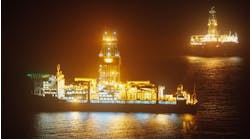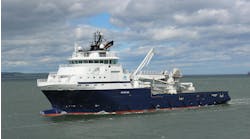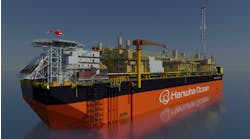Combination winch system saves deck space, speeds changeover
Mooring of the Reading & Bates Falcon drilling semi the RBS-8M - now under construction by Hyundai in Korea - will be effected by one of the world's largest anchor winch systems for an offshore installation. The eight-point, self-contained steel wire/chain mooring system is designed for operations in 8,000 feet water depth, and is initially under a long-term contract to Shell in the Gulf of Mexico. But it is also configured for work in rougher seas such as those found around the Shetland Islands.
Design and manufacture of the traction winch components were performed by Bodewes in Nieuwerkerk a/d Ijssel, The Netherlands, in association with the client. Chain for the mooring system is being provided by a steel supplier in Japan. The contract was awarded in November 1997 and completed by Bodewes this March.
A key factor in gaining the award was the combination of the traction winch and windlass winch onto one frame, the chief benefit being substantial deck space savings. Total deck space occupied by the two traction winch/windlass units plus one drive unit is 35 cu meters. According to Bodewes' Commercial Manager Karel Knevel, the system is also designed for a safer and more rapid changeover than is normally provided on rigs this size.
For a harsh environment semisubmersible with a 6,000 ton plus variable drilling load, 8,000 feet water depth is probably the economic limit for a conventional mooring system. Beyond this depth, synthetic mooring lines, pre-laid mooring systems, or dynamic positioning are required.
In this case, storage drum capacity was sized to accommodate 5 km of 95-mm diameter steel wire and chain, with a total weight of 180,000 kg. The eight winches weigh 800 tons combined, with a 25-ton central drive mech anism. Vrijhof Anchors supplied the Stevpris MK5 18 ton anchors, which are compliant with the latest DNV/MODU rules.
Stacked systems
Combination traction/windlass winch stations are placed on each corner of the rig's deck. Further weight reductions have been achieved through modifications to the frame and drive shafts. "They are not positioned "side/side/side, as in conventional winch systems," explains Bodewes Technical Manager J.Ottenhoff, "but in one frame above each other."
Brake systems comply with the latest DNV/MODU rules (mainband brakes failsafe to provide a holding power for the traction winches of up to 680 tons, or 1,500 kips). In addition, a motor brake offers a line pull to a motor stall of 364 tons. Furthermore, dynamic brakes are installed to run the anchor lines at varible speed to 90 meters/min, and a line pull of 270 tons.
The specially designed gearbox, driven by a flender, features shifting gears with a ratio of 1:2. The system is fully PLC-controlled, with indicators on the user's display screen indicating the position being maintained (whether the system is in high or low gear; the situation regarding clutches, brakes, water-cooling, and so on).
"We tested our own concept using Cosmos-M software for finite element analysis," says Ottenhoff. "That included impact values on the materials we selected for the winches. Reading & Bates Falcon provided the speed and line pull specifications. Our responsibility was to implement these and also to give some weight estimates."
"The system fulfills all the latest DNV Posmoor deepwater requirements relating to modulated bend brakes. Disconnection is via a standard emergency release procedure that can be achieved in five minutes, whatever the conditions. That means five minutes per corner to run out two winches."
Based on the Reading & Bates Falcon specification, Bodewes designed the combined mooring winch using the Cosmos FEA program in order to accommodate the maximum possible stresses. "The system is semiautomatic and adaptable," Ottenhoff adds. "You can choose a fore or aft winch solution."
Bodewes also supplied the fairleads, which have to operate at an angle of 20° due to the novel "spread-out" formation of the RBS-8M's legs. The company is also working with other contractors on deepwater mooring solutions involving synthetic ropes. Recent customers include Noble Drilling, Petrobras, and Bluewater (for the Cairu and Glas Dowr production floaters) and Allseas - Bodewes supplied abandonment and recovery (A&R) traction winches for the large diameter pipelayer, Solitaire.


